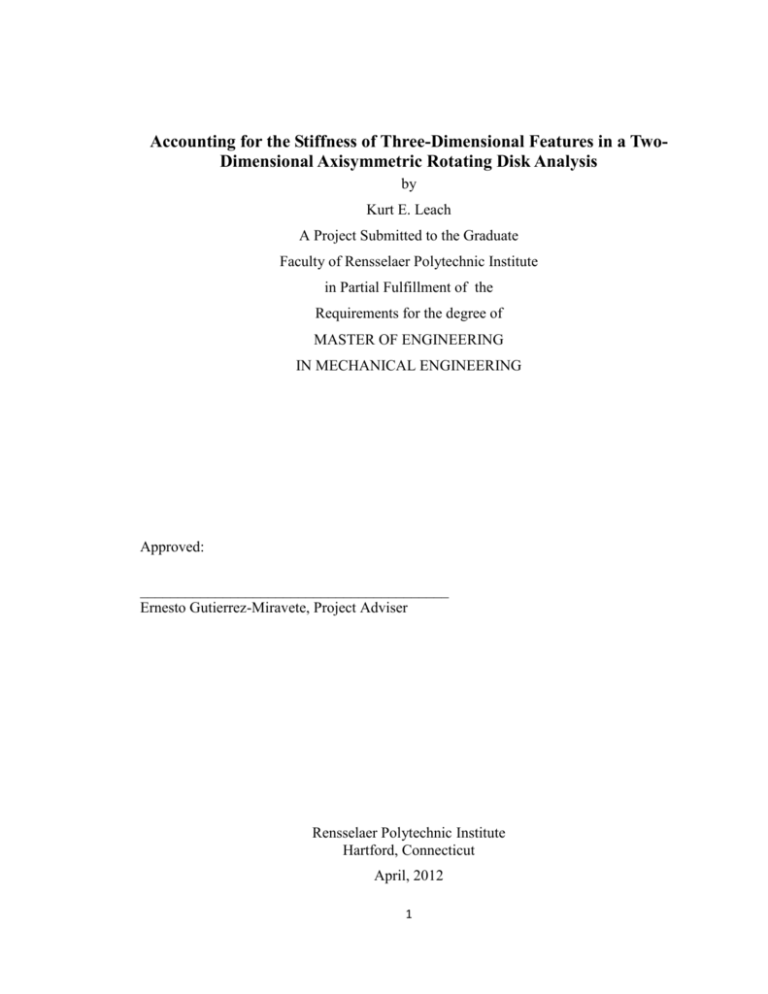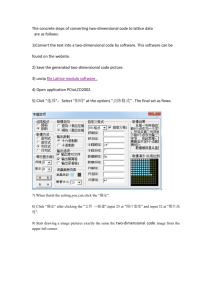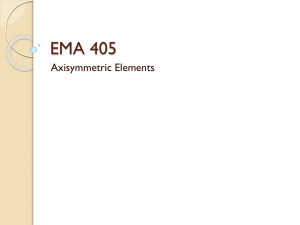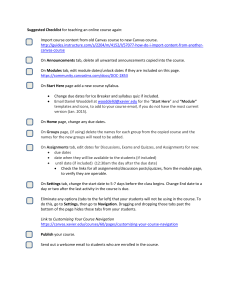
Accounting for the Stiffness of Three-Dimensional Features in a TwoDimensional Axisymmetric Rotating Disk Analysis
by
Kurt E. Leach
A Project Submitted to the Graduate
Faculty of Rensselaer Polytechnic Institute
in Partial Fulfillment of the
Requirements for the degree of
MASTER OF ENGINEERING
IN MECHANICAL ENGINEERING
Approved:
_________________________________________
Ernesto Gutierrez-Miravete, Project Adviser
Rensselaer Polytechnic Institute
Hartford, Connecticut
April, 2012
1
© Copyright 2012
by
Kurt Leach
All Rights Reserved
2
CONTENTS
Accounting for the Stiffness of Three-Dimensional Features in a Two-Dimensional
Axisymmetric Rotating Disk Analysis ........................................................................ 1
LIST OF TABLES ............................................................................................................. 5
LIST OF FIGURES ........................................................................................................... 6
TABLE OF SYMBOLS .................................................................................................... 8
ACKNOWLEDGMENT ................................................................................................... 9
ABSTRACT .................................................................................................................... 10
1. Introduction................................................................................................................ 11
2. Methodology .............................................................................................................. 12
2.1
Description of Problem .................................................................................... 12
2.2
Test Variables................................................................................................... 12
2.3
Analysis Methodology ..................................................................................... 14
2.3.1
CAD Model Creation ........................................................................... 14
2.3.2
FEA Model Creation ............................................................................ 16
2.3.3
Boundary Conditions ........................................................................... 18
3. Results and Discussion .............................................................................................. 20
3.1
3.2
3.3
Model Validation ............................................................................................. 20
3.1.1
Two-Dimensional Model ..................................................................... 20
3.1.2
Three-Dimensional Model ................................................................... 25
Two Dimensional Interface Load vs. Three Dimensional Interface Load ....... 25
3.2.1
Interface Load Results.......................................................................... 25
3.2.2
General Sensitivities............................................................................. 27
Accounting for Stiffness Difference in Two-Dimensional Axisymmetric
Analysis ............................................................................................................ 29
3.3.1
Plane Strain Elements at Tab ............................................................... 29
3.3.2
Plane Strain Elements at Tab with Altered Material Properties in Outof-Plane Direction ................................................................................ 29
3
3.3.3
Axisymmetric Elements at Tab with Altered Material Properties in Outof-Plane Direction ................................................................................ 29
4. References.................................................................................................................. 30
5. Appendix.................................................................................................................... 32
4
LIST OF TABLES
Table 2.1 – Test Matrix for Parameter Evaluation .......................................................... 13
Table 3.1 – Force Summations for All Cases .................................................................. 22
Table 3.2 – Summary of Contact Results for 25% Material Removed Case .................. 23
Table 3.3 – Summary of Contact Results for 50% Material Removed Case .................. 24
Table 3.4 – Summary of Contact Results for 25% Material Removed Case .................. 24
Table 3.5 – Interface Loads for 25% Material Removed Case........................................ 26
Table 3.6 – Interface Loads for 50% Material Removed Case ........................................ 26
Table 3.7 – Interface Loads for 75% Material Removed Case........................................ 26
Table 3.8 – Interface Load as a Function of Mesh Size .................................................. 27
Table 3.9 – Interface Load as a Function of Planar Element Type ................................. 28
Table 3.10 – Interface Load as a Function of Contact Element Type ............................. 29
5
LIST OF FIGURES
Figure 2.1 – Sketch Showing the Tab and Slot of a Typical Interrupted Interface ......... 14
Figure 2.2 – General Dimensions of Generic Rotating Disk used for this Study ............ 15
Figure 2.3 – Schematic showing Sector Angle and Tab Thickness ................................ 16
Figure 2.4 – Finite Element Mesh used for the Two-Dimensional Analysis .................. 17
Figure 2.5 – Finite Element Mesh used for the Three-Dimensional Analysis (shown is
the 50% mat’l removed, 16 tab case)............................................................................... 18
Figure 2.6 – Boundary Conditions to be applied to the Models ...................................... 19
Figure 3.1 – Free body diagram for the 1st Disk (2D Model – 25% material removed
case) ................................................................................................................................. 21
Figure 3.2 – Free body diagram for the 2nd Disk (2D Model – 25% material removed
case) ................................................................................................................................. 22
Figure 3.3 – Plot of Nodal Reaction Forces for All Three Cases .................................... 25
Figure 3.4 – Radial Deflections for Different Mesh Sizes .............................................. 28
6
7
TABLE OF SYMBOLS
TPS = Thickness applied to Plane Stress with Thickness Element (in)
N = Total Number of Tabs
T = Width of One Tab in Circumferential Direction (in)
R = Net section radius (in)
% = Percent Material Removed to create the Tab
Fcentrif = Centrifugal Load (lbf)
m = mass of disk (lbf-s2/in)
r = radial center of mass (in)
ω = Angular Velocity (rad/s)
Fhoop = Radial Constraining Load due to Circumferential Strains (lbf)
σH = Circumferential Stress (psi)
A = Cross-sectional Area of the Fully Circumferential Section (in2)
Finterface = Force transmitted Between 1st Disk and 2nd Disk due to Contact (lbf)
Fconstraint = Reaction force at Radial Constraint (lbf)
8
ACKNOWLEDGMENT
Type the text of your acknowledgment here.
9
ABSTRACT
Type the text of your abstract here.
10
1. Introduction
In the gas turbine industry, both aviation and power generation, the performance and
durability of the engine’s components are of the utmost importance. In aviation gas
turbines, such as commercial turbofan engines, this attention to component durability is
magnified since public safety is in the balance. Therefore, it is essential for any aircraft
engine producer to ensure that safety and component durability are at held in high
regard.
Along with that notion, weight and cost are the biggest drivers toward
competitiveness. One of the biggest weight and cost contributors to a turbofan engine
are the compressor and turbine rotors. The rotors also pose the highest safety in the case
that they fail. With today’s modern advances in finite element analysis, a rotor system
for either a turbine or compressor can be modeled to understand the state of stress in
each rotating component. With today’s capability, it is impractical to create a full threedimensional model of a rotor system; therefore, axi-symmetry is taken advantage of for
modeling these rotors. However, most rotors have non-axisymmetric features such as
holes, tabs, slots, splines, etc. These features are necessary to rotor and engine
functionality; however it can be challenging to model these features in a twodimensional axi-symmetric model. This project will examine the ways that some of the
error caused by non-axisymmetric features, specifically tabs, can be reduced.
11
2. Methodology
2.1 Description of Problem
In two-dimensional rotating disk analyses, three-dimensional out-of-plane features need
to be accounted for since almost all rotors are not perfectly axisymmetric. A popular
way to account for the out-of-plane features is to use plane stress with thickness element
and then apply the appropriate thickness amount to account for the mass of the feature.
In the case of tabs, the thickness that is applied is shown by Equation 2.1.
Equation 2.1
Where:
TPS = Thickness applied to Plane Stress with Thickness Element (in)
N = Total Number of Tabs
T = Width of One Tab in Circumferential Direction (in)
Assuming the same material properties are applied to the plane stress with thickness
elements as the axisymmetric elements, then the mass will be accurately captured;
however, there will be significant differences in stiffness. For the same metal-to-air ratio
in the tab, the same thickness value will be applied regardless of the number of features.
In other words, the thickness value applied in the model will be the same whether there
are 2 large tabs of 100” thickness with or 100 small tabs of 2” thickness. In each of
these instances the stiffness will be different and therefore should be treated differently
in the two-dimensional axisymmetric model. Understanding the difference between the
plane stress with thickness stiffness and the true stiffness (measured with a threedimensional cyclic symmetric model) will be an aid to help determine what corrective
action to take to account of this stiffness difference in the two-dimensional axisymmetric
model.
2.2 Test Variables
The first step in finding a way to correct the stiffness in the two-dimensional axisymmetric analysis is to understand the variables that contribute to the stiffness
difference. A three-dimensional model will be run in order to understand what the true
12
stiffness of the slotted flange should be.
Then it will be compared to the two-
dimensional representation to evaluate the difference in load transferred through the
contact. Here, two variables will be evaluated, the number of tabs and the percent
material removed by the slots.
Number of Tabs
Table 2.1 – Test Matrix for Parameter Evaluation
% Material Removed
25%
50%
75%
4
4
4
8
8
8
16
16
16
32
32
32
64
64
64
The equation for percent material removed by the slot is shown in Equation 2.2.
Equation 2.2
Where: N = Number of Tabs
T = Thickness of One Tab (in)
R = Net section radius (in)
% = Percent Material Removed to create the Tab
The sketch in Figure 2.1 shows the tab thickness defined as well as the slot width for a
sector cut of a typical high pressure turbine rotating disk.
13
Figure 2.1 – Sketch Showing the Tab and Slot of a Typical Interrupted Interface
2.3 Analysis Methodology
2.3.1
CAD Model Creation
First, three-dimensional and two-dimensional solid models must be created in a
Computer Aided Design (CAD) software. For this project, NX 6 was be used to create
the solid models. To make the model creation easier, the CAD model was built using
parametric modeling. By creating a parametric model, the tab thickness and the number
of tabs can be defined at a variable, and when the variable changes, the updates
propagate through the rest of the model. A sketch of the generic model along with some
dimensions is shown in Figure 2.2.
14
Figure 2.2 – General Dimensions of Generic Rotating Disk used for this Study
For the three-dimensional model, the two-dimensional section was swept in order
to create a sector. The sector angle was defined as 360˚ divided by number of tabs
modeled. Equation 2.2 can be rearranged in order to come up with an appropriate tab
thickness for a given the number of tabs and percent of material removed by the tab.
Figure 2.3 shows an example of one of the three-dimensional models that was created
along with the sector angle and tab thickness definition.
15
Figure 2.3 – Schematic showing Sector Angle and Tab Thickness
Using this methodology, all the CAD models necessary to complete the test matrix
will be built.
2.3.2
FEA Model Creation
After the two-dimensional sheet bodies and the three-dimensional solid bodies are
created the models will be imported in to finite element analysis software. For this
project ANSYS will be used as the analysis software. The two-dimensional ANSYS
models will be built first.
2.3.2.1 Two-Dimensional Model
The two-dimensional models will be analyzed using PLANE42 elements. The
axisymmetric option will be used for the axisymmetric regions of the part, and the plane
stress with thickness option will be used to model the tab. The thickness value applied
to the plane stress with thickness region will be equal to the number of tabs multiplied
16
by the tab thickness. For the contacts, CONTAC12 node-to-node contact elements will
be used. An initial contact stiffness of 1E+10 will be used, and the penetrations and
relative sliding will be checked in order to ensure the proper contact behavior.
CONTAC12 elements have a significant advantage over 2D surface-to-surface in terms
of solution time and convergence probability. A mesh size study will be performed in
order to make sure that the loads and deflections are converged as a function of mesh
size.
The two-dimensional mesh size will then be carried over into the three-
dimensional model. Figure 2.4 shows the finite element mesh that will be used for the
two-dimensional analysis.
Figure 2.4 – Finite Element Mesh used for the Two-Dimensional Analysis
2.3.2.2 Three-Dimensional Model
The three-dimensional models will be analyzed using SOLID45 elements. The
axisymmetric portion of the two disks will be sweep meshed such that each of the
symmetry boundaries has a matching mesh. This facilitates the application of cyclic
symmetric boundary conditions.
The cyclic symmetric boundary condition can be
achieved by coupling the nodes on one symmetry boundary with the corresponding
nodes on the opposite symmetry boundary in all degrees-of-freedom (radial, axial and
17
circumferential).
The contact will be modeled with CONTA174 surface-to-surface
contact elements with a contact stiffness of 1E+10. Again, the penetration amounts will
be checked in order to ensure that this is an appropriate value. Figure 2.5 shows the
finite element mesh that will be used for the 50% percent material removed, 16 tab case.
Figure 2.5 – Finite Element Mesh used for the Three-Dimensional Analysis (shown is the 50% mat’l
removed, 16 tab case)
2.3.3
Boundary Conditions
The boundary conditions will be iterated in the two-dimensional axisymmetric
model in order to generate a contact load on the order of 100,000 lbs for the full
circumference. The 1st Disk will be fixed at the inner diameter in the axial direction and
the 2nd Disk will be fixed at the inner diameter in the radial and axial directions. The
rotation speed will be iterated in order to come up with a value that meets the load
criteria.
18
Figure 2.6 – Boundary Conditions to be applied to the Models
After some iteration, a value of 12,000 RPM was chosen for the rotational speed. This is
on the order of magnitude of the operation of a commercial jet engine high turbine rotor.
Also, it provides on the order of 100,000 lbs of interface load which it typical of an HPT
rotor interface load.
19
3. Results and Discussion
3.1 Model Validation
3.1.1
Two-Dimensional Model
3.1.1.1 Free-Body Diagram
In order to validate the model behavior, a free-body diagram was created of both the
components. The main loads acting on the two disk are the centrifugal load due to the
angular rotation (Fcentrif), the radial constraint due to the circumferential strains (Fhoop),
the contact load (Finterface) and the radial constraint (Fconstraint). The centrifugal load due to
the angular rotation was approximated by Equation 3.1.
Equation 3.1
Where:
Fcentrif = Centrifugal Load (lbf)
m = mass of disk (lbf-s2/in)
r = radial center of mass (in)
ω = Angular Velocity (rad/s)
The radial constraint due to the circumferential strain is approximated by Equation 3.2.
Equation 3.2
Where:
Fhoop = Radial Constraining Load due to Circumferential Strains (lbf)
σH = Circumferential Stress (psi)
A = Cross-sectional Area of the Fully Circumferential Section (in2)
The interface load and the reaction at the radial constraint were extracted directly from
the analysis results. Figure 3.1 shows the free-body diagram of the 1st disk with all the
loads for the 25% material removed case.
20
The 1st disk shows a residual radial force of 4,000 lbs. This difference can be due to the
approximation of Fcentrif and Fhoop for this system. However, this is only 0.1% of the
highest load on the disk and about 2.5% of the interface load.
Figure 3.1 – Free body diagram for the 1st Disk (2D Model – 25% material removed case)
Figure 3.2 shows the 2nd disk free body diagram.
21
Figure 3.2 – Free body diagram for the 2nd Disk (2D Model – 25% material removed case)
The 2nd disk shows a residual force for 500 lbs. Again, this difference can be attributed
to the approximation of the centrifugal load and the hoop constraint. Table 3.1 shows
the force summations for all three cases.
Table 3.1 – Force Summations for All Cases
Overall, based on these force summations, the two-dimensional axisymmetric model is
behaving as expected and all the forces are accounted for within some tolerance.
22
3.1.1.2 Global Deflections
3.1.1.3 Contact Checks
The contact behavior in the two-dimensional model needs to be validated in order to
ensure that the contact elements are behaving as expected.
Some of the checks
performed include: checking contact load distribution, contact penetration, relative
motion between contact node pairs, and element status. Table 3.2 shows a summary of
the aforementioned results for the 25% material removed case.
Table 3.2 – Summary of Contact Results for 25% Material Removed Case
Here it is shown by looking at the contact element status that only the last two elements
along the surface are in contact, and the remaining elements are out of contact. This
result is verified by the fact that the last two elements are transmitting a load and the
other contact elements are not. Also, the elements that are not in contact show a gap
between the node pairs, whereas the elements in contact show some amount of
penetration. This penetration is necessary in order to gain model convergence, however
to large of penetration can lead to incorrect model results. A typically accepted value for
contact penetration is ~0.1 mils, and here 0.01 mils of penetration is shown. Therefore,
the contact stiffness chosen (1E+10) is sufficient enough for this particular application.
Also, the relative axial motion between the contacts was evaluated. The amount of
relative motion between the node pairs is around 0.010” for all of the contact pairs. The
global element size in this analysis is 0.050” and therefore, the relative axial motion of
the contact node pairs only consumes about 20% of the element length and therefore, the
23
uses of a node-to-node contact type is sufficient for this analysis.
For further
verification, see section 3.2.2.3 where a sensitivity to contact element type is performed.
Summaries of the contact results for the 50% and 75% percent material removed case
are shown in Table 3.6 and Table 3.7 respectively.
Table 3.3 – Summary of Contact Results for 50% Material Removed Case
Table 3.4 – Summary of Contact Results for 25% Material Removed Case
For these two cases, appropriate contact behavior is validated in the same manner that
the 25% material removed case was. The elements in contact show a radial force
transmitted and a small amount of penetration, and the elements out of contact show a
gap between node pairs and no transmission of load. The contact penetration amounts
are appropriate for this application and the relative axial motion levels are acceptable.
One difference between the cases is that as the percent material removed increases, the
24
radial load becomes more distributed along the contacting surface. This is validated also
by looking at nodal reaction plots of the contact surface as seen in Figure 3.3.
Figure 3.3 – Plot of Nodal Reaction Forces for All Three Cases
The nodal force plot validates the contact behavior with respect to the load distribution
along the contacting surface. Overall, the contact elements are behaving correctly and
the contact element type and contact stiffness chosen are appropriate for this application.
3.1.2
Three-Dimensional Model
3.1.2.1 Comparison of Three-Dimensional Results to Two-Dimensional Results
3.2 Two Dimensional Interface Load vs. Three Dimensional Interface
Load
After running the model at the aforementioned boundary conditions, the results were
post-processed in order to understand the differences in interface load between the twodimensional axisymmetric model and the three-dimensional cyclic symmetry model.
3.2.1
Interface Load Results
Table 3.5, Table 3.6 and Table 3.7 show the differences between the two-dimensional
axisymmetric model and the three-dimensional cyclic symmetric model for the 25%,
50% and 75% material removed for the tab cases respectively.
25
Table 3.5 – Interface Loads for 25% Material Removed Case
Table 3.6 – Interface Loads for 50% Material Removed Case
Table 3.7 – Interface Loads for 75% Material Removed Case
Here it is evident that the difference between the two-dimensional axisymmetric
model and the three-dimensional cyclic symmetric model increases as the number of
tabs decrease. This difference was shown to be as high 34.3% for the 75% material
removed – 4 tab case. It is clear that the method of using plane stress with thickness
elements to model the tab in the two-dimensional axisymmetric model is not sufficient in
cases where there is a small quantity of tabs with a large thickness. As the number of
tabs increase and therefore the tab width decreases, the interface load for the three26
dimensional cyclic symmetric model begins to converge on the two-dimensional
axisymmetric model interface load. This is because the tabs decrease in width and the
tabs region becomes a plane stress application. For plane stress theory to be completely
applicable, the thickness must be one-tenth of the smallest in-plane dimension. For this
case, that would mean that the tab width would need to be 0.040”. However, for the
purposes of only capturing the overall stiffness of the tab (and not the stresses in the
two-dimensional axisymmetric model), the limits may need to expanded.
3.2.2
General Sensitivities
In order to ensure that the solid element type, mesh size and contact element type used
were appropriate, a number of sensitivity studies were performed, including mesh size,
axisymmetric element type, and contact element type.
3.2.2.1 Mesh Size
The mesh in the two-dimensional axisymmetric model was iterated from a global
element size of 0.050” down to 0.010”. The following table shows the interface load for
a given case as a function of mesh size.
Table 3.8 – Interface Load as a Function of Mesh Size
The data shows that the maximum difference between a mesh size of 0.010” and
0.050” is about 0.2%. Therefore a mesh size of 0.050” is sufficient for this analysis.
27
Figure 3.4 shows the radial deflections for different mesh sizes. The differences in the
global radial deflections between the different mesh size cases are indecipherable.
Figure 3.4 – Radial Deflections for Different Mesh Sizes
The 0.050” element mesh size will continue to be used for this analysis. This allows for
accurate results, meanwhile providing sufficient computational efficiency. This mesh
size will also be used for the three-dimensional analysis, using this study as a basis.
3.2.2.2 Solid Element Type
There are two different four node planar element types available for use in ANSYS, the
PLANE42 and the PLANE182 (both have axisymmetric and plane stress with thickness
options). Here a general sensitivity was performed in order to be sure that these element
types yield consistent results. Table 3.9 shows that there is essentially no difference in
interface load between the two different element types.
Table 3.9 – Interface Load as a Function of Planar Element Type
28
3.2.2.3 Contact Element Type
In the two-dimensional model, there are a number of different options for contact
elements. Here, node-to-node contact (CONTAC12) and two-dimensional surface-tosurface contact (CONTA172) were evaluated. Table 3.10 shows the interface load
results for the two contact element types.
Table 3.10 – Interface Load as a Function of Contact Element Type
The node-to-node contact element is not suited well for analysis where large deflections
and large rotations come in to play, however, they are far more robust and
computationally efficient than the surface-to-surface contact elements. Here it is shown
that the load does not change significantly between the contact element types, and
therefore the node-to-node contact elements will continue to be used for this study.
3.3 Accounting for Stiffness Difference in Two-Dimensional
Axisymmetric Analysis
3.3.1
Plane Strain Elements at Tab
3.3.2
Plane Strain Elements at Tab with Altered Material Properties in Out-ofPlane Direction
3.3.3
Axisymmetric Elements at Tab with Altered Material Properties in Out-ofPlane Direction
29
4. References
[1]
ANSYS 11.0 Theory Reference, ANSYS Corporation, 2007
[2]
Budynas, Richard Gordon, Joseph Edward Shigley, and J. Keith Nisbett.
Shigley’s Mechanical Engineering Design. 8th ed. New York, NY: McGraw-Hill
Science/Engineering/Math, 2008.
[3]
Davis, Erica. “A Study of a Combined 2D Axisymmetric and 3D Cyclically
Symmetric Finite Element Model of a Turbine Disk” RPI Master's Project
http://www.ewp.rpi.edu/hartford/~ernesto/SPR/Davis-FinalReport.pdf
[4]
Hassan, Mohammed. “Vibratory Analysis of Turbomachinery Blades” RPI
Master's Project http://www.ewp.rpi.edu/hartford/~ernesto/SPR/Hassan-FinalReport.pdf
[5]
Cook, Robert D. Concepts and Applications of Finite Element Analysis. 4th Ed.
John Wiley and Sons, 2002
[6]
Meguid, S.A., P.S. Kanth, and A. Czekanski. "Finite element analysis of fir-tree
region in turbine discs." Finite elements in analysis and design. 35.4 (2000): 305-317.
Web. 1 Feb. 2012.
[7]
Sun, W. “Bolted joint analysis using ANSYS superelements and gap elements”.
4th Int ANSYS Conf Exhib 1989 Part 2, p 6.66-6.75, 1989. Publ by ANSYS
[8]
Jettappa, Richard Rodrigues. “Pseudo-density approach to the solution of a thin
rotating turbine engine disk”. Proceedings of the ASME Turbo Expo, v 6, PARTS A
AND B, p 1087-1095, 2010, ASME Turbo Expo 2010: Power for Land, Sea, and Air, GT
2010. Publ by ASME
30
[9]
Beisheim, J. R. “Three-dimensional finite element analysis of dovetail
attachments with and without crowning”. Journal of Turbomachinery, v 130, n 2, April
2008. Publ by ASME
31
5. Appendix
32







